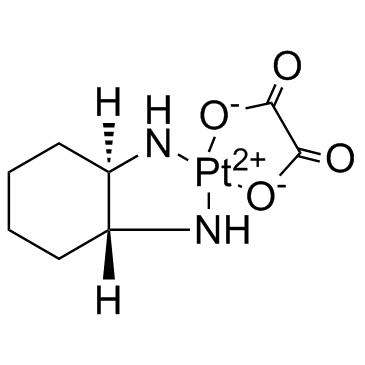奥沙利铂

奥沙利铂结构式

|
常用名 | 奥沙利铂 | 英文名 | Oxaliplatin |
|---|---|---|---|---|
| CAS号 | 61825-94-3 | 分子量 | 395.28 | |
| 密度 | N/A | 沸点 | 193.6ºC at 760 mmHg | |
| 分子式 | C8H12N2O4Pt | 熔点 | N/A | |
| MSDS | 中文版 美版 | 闪点 | N/A | |
| 符号 |


GHS07, GHS08 |
信号词 | Warning |
|
VGluT3⁺ primary afferents play distinct roles in mechanical and cold hypersensitivity depending on pain etiology.
J. Neurosci. 34(36) , 12015-28, (2014) Sensory nerve fibers differ not only with respect to their sensory modalities and conduction velocities, but also in their relative roles for pain hypersensitivity. It is presently largely unknown which types of sensory afferents contribute to various forms o... |
|
|
PKM2 Subcellular Localization Is Involved in Oxaliplatin Resistance Acquisition in HT29 Human Colorectal Cancer Cell Lines.
PLoS ONE 10 , e0123830, (2015) Chemoresistance is the main cause of treatment failure in advanced colorectal cancer (CRC). However, molecular mechanisms underlying this phenomenon remain to be elucidated. In a previous work we identified low levels of PKM2 as a putative oxaliplatin-resista... |
|
|
Atonal homolog 1 protein stabilized by tumor necrosis factor α induces high malignant potential in colon cancer cell line.
Cancer Sci. 106 , 1000-7, (2015) Patients with inflammatory bowel disease (IBD) have an increased risk of developing colitis-associated colorectal cancer (CAC). CAC cells often develop chemoresistance, resulting in a poorer prognosis than that of sporadic colorectal cancer (CRC). The mechani... |
|
|
Comparative Study of 17-AAG and NVP-AUY922 in Pancreatic and Colorectal Cancer Cells: Are There Common Determinants of Sensitivity?
Transl. Oncol. 7(5) , 590-604, (2014) The use of heat shock protein 90 (Hsp90) inhibitors is an attractive antineoplastic therapy. We wanted to compare the effects of the benzoquinone 17-allylamino-17-demethoxygeldanamycin (17-AAG, tanespimycin) and the novel isoxazole resorcinol-based Hsp90 inhi... |
|
|
Treatment of oxaliplatin-induced peripheral neuropathy by intravenous mangafodipir.
J. Clin. Invest. 124(1) , 262-72, (2014) The majority of patients receiving the platinum-based chemotherapy drug oxaliplatin develop peripheral neurotoxicity. Because this neurotoxicity involves ROS production, we investigated the efficacy of mangafodipir, a molecule that has antioxidant properties ... |
|
|
The search for treatments to reduce chemotherapy-induced peripheral neuropathy.
J. Clin. Invest. 124(1) , 72-4, (2014) Oxaliplatin, a commonly used chemotherapeutic agent, is associated with both acute and chronic neurotoxicity. Chronic sensory neuropathy can be dose limiting and may have detrimental effects on patients' quality of life. Preclinical studies provide an underst... |
|
|
Effect of the norepinephrine transporter (NET) inhibition on μ-opioid receptor (MOR)-induced anti-nociception in a bone cancer pain model.
J. Pharmacol. Sci. 125(3) , 264-73, (2014) Although norepinephrine transporter (NET) inhibition has an additional effect on μ-opioid receptor (MOR)-mediated anti-nociception in inflammatory and neuropathic pain, its effect on cancer pain is not well characterized. We investigated the additional effect... |
|
|
Goshajinkigan, a traditional Japanese medicine, prevents oxaliplatin-induced acute peripheral neuropathy by suppressing functional alteration of TRP channels in rat.
J. Pharmacol. Sci. 125(1) , 91-8, (2014) The acute peripheral neuropathy induced by oxaliplatin treatment occurs very frequently and is aggravated by exposure to cold. Goshajinkigan (GJG), a traditional Japanese (kampo) medicine, was recently shown to be effective against oxaliplatin-induced acute n... |
|
|
Defining the role of MRP-mediated efflux and glutathione in detoxification of oxaliplatin.
Pharmazie 68(7) , 622-7, (2013) Albeit platinum complexes are widely used in cancer chemotherapy, their cellular processing has not been completely elucidated so far. In this study the effects of modulating multidrug resistance-associated protein (MRP)-mediated efflux and glutathione (GSH) ... |
|
|
The contribution of Gi/o protein to opioid antinociception in an oxaliplatin-induced neuropathy rat model.
J. Pharmacol. Sci. 126(3) , 264-73, (2014) Oxaliplatin is a chemotherapeutic agent that induces chronic refractory neuropathy. To determine whether opioids effectively relieve this chronic neuropathy, we investigated the efficacies of morphine, oxycodone, and fentanyl, and the mechanisms underlying op... |